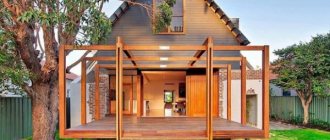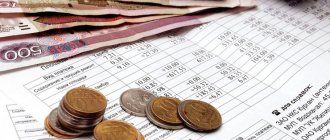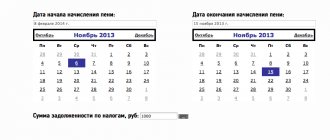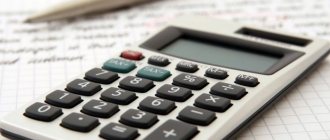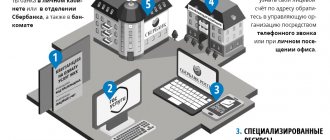How to decipher a receipt for housing and communal services?
Decoding a housing and communal services receipt is a fairly pressing issue for many citizens, since due to the use of abbreviations and abbreviations it is quite difficult to understand. This may lead to readings being entered in the wrong columns, which may result in debt or overpayment. Let's take a closer look at what the designations mean in housing and communal services payment documents.
Water disposal
Drainage is sewage. Payment is calculated according to the formula: Votv = (Vxv * tariff) + (Vgv * tariff). To translate it into a more understandable language: the cost of sewerage services is the sum of the volume of cold water multiplied by the tariff, and the volume of hot water consumption multiplied by the tariff rate. In modern multi-storey buildings, common building water meters are often installed; in this case, the cost depends on the number of people registered in the living space.
HVS
supply - cold water supply, is taken into account using a house (DPU) or apartment (KPU) metering device. If the meter is not installed, the number of residents is multiplied by the tariff.
DHW
DHW - hot water supply, centralized supply, if there is a DPU addition, then a meter is installed in the house.
Cold water for domestic hot water
Cold water for domestic hot water - simply put, this is the amount of cold water required to produce hot water. In this case, the cost for cold water is included.
Water heating
Water heating (CW heating for domestic hot water) - heating of cold water to produce hot water. The cost of energy spent on heating water is indicated.
MSW
MSW is municipal solid waste, that is, everything that is thrown into garbage chutes or containers. The calculation is made according to the following scheme: the number of registered people is multiplied by the tariff, in some cases the tariff is multiplied by the area of the apartment in square meters;
OI
POI – common property, which includes common areas of the house, namely entrances, elevators, attics and basements, stairs, etc.
ODN (SOI)
ODN (common house needs) or SOI – maintenance of common property. Payment is calculated according to city or regional tariffs. One charge for electricity, if there is a common house meter, is calculated as follows: the amount of electricity that consumers spent for their own needs is subtracted from the total amount, the remaining amount is divided by the total area of all apartments, payment is determined based on the meter of the total area of the apartment.
Maintenance of living quarters
Maintenance of residential premises - many people mistakenly understand this as the maintenance of personal housing, but this is not so. This item includes services and work on managing the house, payment of expenses for its current repairs, maintenance, utilities, for example, payment for the work of a cleaner and janitors. The amount is calculated as follows: the management company calculates the annual budget, this figure is divided by the number of owners, and then by 12 months. The amount received is paid monthly.
ODPU
ODPU - common house metering devices. According to Federal Law No. 261, owners are required to install ODPU (if technically possible). The device can be a single device or a complex of measuring instruments. The amount of payment for the shared ownership rights for each premises is calculated in proportion to the share in the right of common ownership.
CPU
KPU - collective metering devices. These are all meters that are installed throughout the entire apartment building.
IPU
IPU is an individual metering device, meters installed in the apartment; in some cases, for example, electricity IPU are installed in the common corridor at the entry point into the apartment. Today, meters are installed for electricity, gas, cold, hot water, and heat. Paying by meters is much more profitable than by tariff, especially if those registered in the living space do not live at the place of registration.
ROM
ROM is an intercom and locking device, in other words, an intercom. If the device was installed on the initiative and at the expense of the residents, the property does not belong to common property and should not be included in receipts for payment of utility services. ROM is paid according to a separate receipt from the organization with which the contract was concluded.
ASU
AZU – automatic locking device, remotely controlled lock. It can be installed together with an intercom (most often) or without the latter. If the ADU is provided for by the house design, the Criminal Code has been established, it is included in the home property.
VDGO
VDGO - in-house gas equipment, gas pipes, locking devices, equipment for general use, as well as private stoves, columns and pipes that lead to them. A fee is charged for periodic inspection, repair work, and maintenance. Due to the increasing number of cases of household gas explosions, each user is required to conclude a VDGO service agreement.
VKGO
VKGO – indoor gas equipment. This is a new line in the payment order; it has not yet been introduced in all regions. This is a payment for the maintenance of apartment equipment, which is calculated only after signing an agreement with the service company.
UUTE
UUTE – thermal energy metering unit. This is a system that consists of devices for recording coolant parameters. Installing a unit makes it possible to save money without paying extra, for example, in case of heat loss on the main line. Also, when hot water is turned off, there is no charge. If the receipt contains the UUTE column, then the payment is for its installation, maintenance, and repair. Since the cost of the metering unit is quite impressive, the payment is divided into many payments so that it is not expensive for residents.
AUR
AUR – administrative and management expenses. Here the expenses for the salaries of the manager, accountants, office expenses, etc. are paid. If the house is on the balance sheet of a government body, this line should remain empty, since the contents of the management company are on the balance sheet of the city budget.
AHR
AHR are administrative expenses, almost the same as AUR.
ELS
ULS – single personal account. It greatly simplifies the payment procedure. To find out your ULS Housing and Communal Services, you need to go to the GIS Housing and Communal Services website, go through authorization, go to your personal account and connect your personal account to your account (if it does not exist). If you have already gone through this procedure, the account will be displayed in the “list of connected personal accounts” line.
FLS
FLS – financial and personal account. It displays the amount of accruals, actual payment, and benefits provided. It should be taken into account that when registering an apartment in a new building, you need to register a personal account yourself.
WIN
UIN is a unique accrual identifier; it is a code consisting of 25 characters that is assigned to the payment by the recipient of the payment.
PC
PC – multiplying factor. This is one of the types of penalties, indicated as a PC number multiplied by the established tariff. An increasing factor is assigned if the homeowner does not comply with the requirements of regulations and does not install mandatory metering devices.
EDV
EDV - a monthly cash payment is assigned to preferential categories of citizens as compensation for paying for housing and communal services. To receive EDV, you must personally submit an application and a package of documents (passport, documents on housing ownership and confirming your right to benefits).
UNM
UNM is a single payment document, this is the payment itself, a receipt that is provided to property owners or tenants on a monthly basis. UNM includes not all, but most of the cost items for payment of housing and communal services.
Payer code
Payer code (bar code) – information about the payer in graphic form, which makes it possible to scan the receipt with hardware. After introducing the barcode, making payments through terminals became quite simple; you do not need to enter data, you can simply bring the payer’s graphic code to the reading device. They can be linear (in the form of a series of stripes) and two-dimensional (a picture in a square, a QR code).
Balance
Balance - this column on receipts is often left blank. The balance can have a positive or negative value, which represents the difference that occurs when you overpay or underpay the actual payment amount. The balance may also reflect the amount that you paid, but there was an error during the banking transaction.
Recalculation
Recalculation. If it is necessary to settle an overpayment or underpayment that occurred when paying bills, a recalculation is carried out. As a result, the final amount may be increased or decreased. Recalculation is carried out for payment for garbage removal, water supply, gas supply, sewerage, heating and electricity.
Penalty
Penalties are fines that are assessed for late payment.
Voluntary insurance
Voluntary insurance - included in payments from August 2021. If you find amounts in this column on your receipt, you can pay or ignore them. Making a payment signifies the homeowner's consent to participate in the home accident insurance program.
Target fee (contribution)
Target fee (contribution) - it is charged only after a general meeting of residents, determination of the final amount and deadlines for payment. Contributions may be charged for various types of repairs, elevator maintenance, insulation repairs, reconstruction, etc.
TV broadcast (TV antenna)
Television broadcast (TV antenna) is payment for a collective television antenna. If you do not need this service, you can refuse it by writing a statement at the company’s office, through your personal account, or the MFC. Payment will stop coming after the worker arrives and disconnects the antenna from the apartment.
Renting housing
Rental housing - accrued upon concluding an agreement between a citizen and the state when providing him with municipal (social) housing for use.
Maintenance
Maintenance - the specified tariff is established by the Housing Code of the Russian Federation, in most regions it is 14.425. The money is used for housing maintenance, repair work, snow removal, roofing work, emergency repair services, etc.
Do I have to pay the debts of the previous homeowner?
The debt does not belong to the apartment, but to its owner. Therefore, the new owner should not pay, unless, of course, this is provided for in a separate clause of the purchase and sale agreement. The law clearly states this. At the same time, according to the Housing Code, debt on contributions for major repairs must be paid by the current owner, regardless of when and under which owner it arose. Therefore, it is important to check the debt before concluding a purchase and sale transaction. Buyers often neglect to check, assuming that repair fees are regulated by the code, which states that the new owner is not responsible for the debts of the old one. Alas, this only applies to utilities.
Payment order
How to pay utility bills using receipts?
The billing period for making payments for housing and communal services is a calendar month.
Typically, it must be paid by the tenth day of the month following the reporting month. However, other deadlines may be set. The exact date by which the next payment must be made is indicated on the receipt itself.
You must pay on time and in the prescribed amount. For late and incomplete payment, penalties may be charged (1/300 of the bank refinancing rate).
There are several ways to transfer funds to pay housing and communal services:
- at any post office;
- through banks (other credit institutions);
- through the Internet;
- using mobile communications.
Payment by meters
How is payment for metered services calculated?
According to current legislation, metering of consumed water, heat and electricity must be carried out based on meter readings. These readings must be included on your monthly receipts.
If the readings are not indicated, then within three months calculations will be made based on average values. And then they will be produced according to general standards for consumers who have not installed the devices.
The fee is calculated taking into account these data and established tariffs and consumption standards.
Information from meters must be recorded reliably. Once every six months, management companies check the accuracy of these readings. At the same time, meters should be installed not only in apartments, but also on the house as a whole.
Payment without meters
Despite the established rules, not all apartments still have meters. Persons who have not installed devices will have to pay based on an increasing coefficient from the beginning of this year.
That is, when calculating the fee, the consumption standard, the number of residents, the tariff, as well as this coefficient will be taken into account. In fact, the fee for them will be increased by one and a half times.
It should be noted that tariffs for water and other resources may vary in different regions. Consequently, the payment for its consumption, both with and without meters, may be different.

